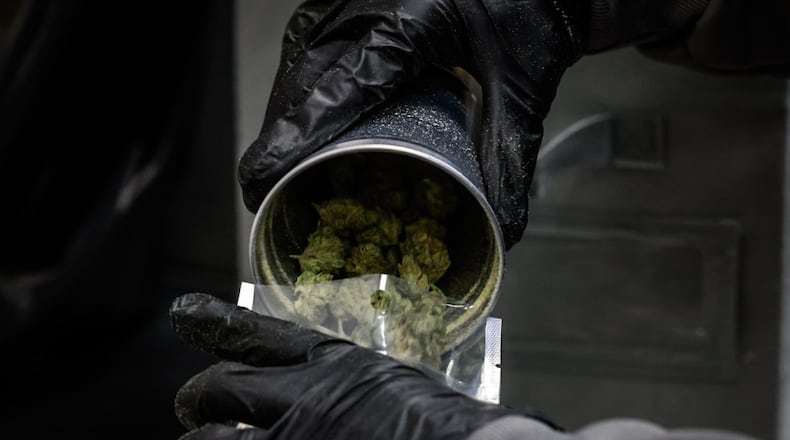Ohio’s current law deems someone intoxicated by cannabis if their blood has 10 nanograms of THC per milliliter (ng/ml) or if their urine contains more than 2 ng/ml. Someone could also be charged with an OVI if their blood contains 50 ng/ml of THC metabolites (which are created as the body processes cannabis) or if their urine contains more than 35 ng/ml of THC metabolites.
“It is still illegal to drive impaired, no matter what people believe the law is now with marijuana,” said Montgomery County Sheriff Rob Streck. “Whether you’re drinking alcohol, whether you’re smoking marijuana or using heavier drugs.”
Testing for marijuana impairment
Streck said his agency is expecting an uptick in impaired driving following the legalization of marijuana in Ohio — more people may be feeling more comfortable with using cannabis.
“Whether people admit it or not, there are individuals who don’t do things because it is illegal. People now feel more comfortable smoking,” he said. “We do believe there are going to be additional people driving impaired now. We do believe people are going to be smoking and driving.”
An investigation into impaired driving can begin from a person calling in to report a motorist driving erratically, a deputy noticing someone with erratic driving patterns or a crash occurring.
“It’s not that we’re doing anything differently,” Streck said. “But we are making sure that we’re really up to date on what to look for.”
The smell of marijuana, visible cannabis products, bloodshot eyes and slurred speech can all be signs of impairment to a deputy making a traffic stop. A deputy can also run a series of sobriety tests taught under Advanced Roadside Impaired Driving Enforcement when talking to a motorist, and the driver can also be asked to submit to a chemical test. Declining to participate in chemical testing can result in license suspensions.
Much like with alcohol, people can consume cannabis sometime before driving and still be under the legal limit for marijuana intoxication.
Legal complications
Cincinnati-based OVI lawyer Joe Suhre said some of the challenges with Ohio’s adult-use law aren’t entirely new; legal professionals have been working on cases related to medical marijuana since the state’s medical program began in 2017.
The law prohibits using marijuana in a vehicle, or operating a vehicle while under the influence of cannabis. But breathalyzers for weed are newer technology, not commonplace and typically detect recent cannabis use, not intoxication.
Oftentimes, police can also request a urine sample if they suspect intoxication by marijuana. But Suhre said marijuana metabolites stick to fat tissues in the body and take several days or longer to completely leave the body.
“Any toxicologist that will testify, and I have cross examined dozens of them over the years, will say, ‘I cannot tell you because of a metabolite level if someone is under the influence because the urine doesn’t correlate like blood does,’” Suhre said.
A person driving in Ohio could lawfully use marijuana on a Saturday, Suhre said, and be involved in a car crash while driving sober the following Monday. This person could face charges related to impaired driving if they consent to a urine sample and see results higher than the legal limit of 35 ng/ml for marijuana metabolites.
Impaired driving sees more crashes
Drug-related crashes saw a 4% increase from 2022 to 2023 in Ohio. During the time period, Montgomery County was ranked in the top five Ohio counties for drug-related crashes, according to Ohio State Highway Patrol data.
The top counties in Ohio for drug-related fatal crashes — Franklin (285 crashes), Cuyahoga (228), Montgomery (139), Hamilton (139, tied for third with Montgomery), and Summit (93) — made up 30% of all drug-related crashes in the state from 2022 to 2023.
State troopers also made a total of 3,319 drug-related OVI arrests last year. This included 739 arrests specifically tied to marijuana impairment and an additional 715 arrests linked to a combination of marijuana and other drugs, according to the Ohio State Highway Patrol.
Sgt. Tyler Ross of the state patrol’s Public Affairs Unit said state troopers are trained regularly on ways to recognize the signs of impairment related to drugs, alcohol or a combination of the two.
“A top priority for the Ohio State Highway Patrol is the same now as it always has been and will continue to be, and that’s to save lives,” said Ross. “The Ohio State Highway Patrol focuses on removing impaired drivers to make our roadways safer for not only the citizens of Ohio, but also those traversing our state.”
About the Author

